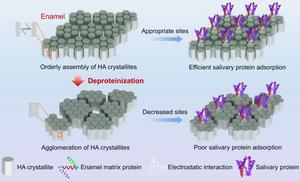Friction ( IF 6.3 ) Pub Date : 2024-07-22 , DOI: 10.1007/s40544-024-0873-8 Hujun Wang , Yue Tang , Haonan Qiu , Jingyang Hu , Yuan Su , Jing Zheng , Zhongrong Zhou

|
Anti-wear performance of human enamel in the mouth is closely related to the lubrication of salivary pellicle. It is well known that the inorganic hydroxyapatite (HA) of the enamel plays an important role in the adsorption and pellicle-forming of salivary proteins on the enamel, but the role of enamel matrix proteins remains unclear. In this study, the adsorption and lubrication behavior of salivary proteins on original, heated, and deproteinated enamel surfaces was comparatively investigated using an atomic force microscopy and nano-indentation/scratch techniques. Compared with that on the original enamel surface, the adsorption and lubrication behavior of salivary proteins remains almost unchanged on the heated enamel surface (where the enamel matrix proteins are denatured but the size of HA crystalline nanoparticles keeps constant) but exhibits an obvious compromise on the deproteinated enamel surface (where the enamel matrix proteins are removed and agglomeration of HA crystallites occurs). The HA agglomeration weakens the electrostatic interaction of enamel surfaces with salivary proteins to cause a distinct negative influence on the adsorption and pellicle-forming of salivary proteins. Further, the negative effect is confirmed with a quartz crystal microbalance with dissipation. In summary, by regulating enamel nanostructure for appropriate electrostatic interactions between salivary proteins and enamel surfaces, the enamel matrix proteins play an essential role in the adsorption and pellicle-forming of salivary proteins on human enamel, and then contribute to saliva lubrication, which provides the enamel with an anti-wear mechanism. The findings will promote and assist the design of enamel-inspired anti-wear materials.
中文翻译:

牙釉质基质蛋白促进唾液润滑
人体口腔牙釉质的抗磨损性能与唾液表膜的润滑密切相关。众所周知,牙釉质中的无机羟基磷灰石(HA)在唾液蛋白在牙釉质上的吸附和表膜形成中发挥着重要作用,但牙釉质基质蛋白的作用尚不清楚。在这项研究中,使用原子力显微镜和纳米压痕/划痕技术对唾液蛋白在原始、加热和脱蛋白牙釉质表面上的吸附和润滑行为进行了比较研究。与原始牙釉质表面相比,加热牙釉质表面唾液蛋白的吸附和润滑行为几乎没有变化(牙釉质基质蛋白发生变性,但HA晶体纳米粒子的尺寸保持不变),但对唾液蛋白的吸附和润滑行为表现出明显的妥协。去蛋白的牙釉质表面(牙釉质基质蛋白被去除,HA 微晶发生聚集)。 HA团聚削弱了牙釉质表面与唾液蛋白的静电相互作用,对唾液蛋白的吸附和薄膜形成产生明显的负面影响。此外,通过具有耗散的石英晶体微天平证实了负面影响。总之,通过调节牙釉质纳米结构以实现唾液蛋白与牙釉质表面之间适当的静电相互作用,牙釉质基质蛋白在唾液蛋白在人体牙釉质上的吸附和表膜形成中发挥着重要作用,进而有助于唾液润滑,从而提供具有抗磨损机制的珐琅。这些发现将促进和协助搪瓷抗磨材料的设计。






























 京公网安备 11010802027423号
京公网安备 11010802027423号